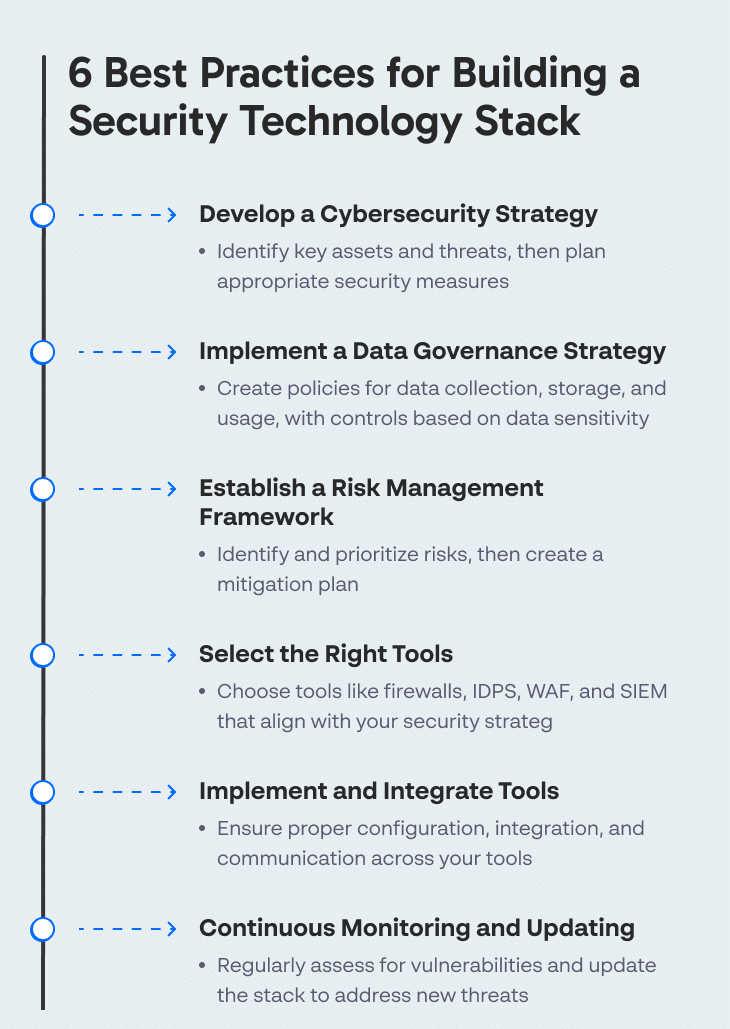Security Stack Examples and 6 Best Practices for Building Your Stack
What Is a Security Stack?
A security stack is a collection of security tools and technologies that are used to protect an organization’s information and assets. A security stack typically includes a combination of software, hardware, and processes that work together to provide multiple layers of protection. The goal of a security stack is to provide a comprehensive and integrated approach to security that can help an organization detect, prevent, and respond to security threats.
This is part of a series of articles about incident response
Examples of Security Stacks
The following are common examples of security stacks many organizations deploy to protect their valuable assets and data.
Zero-Trust Security Stack
Zero-trust is a security model that helps protect organizations against insider threats. It treats all users as suspicious, even if previously authenticated, and denies access to digital resources by default. A zero-trust framework typically uses the following components:
- A zero-trust architecture (ZTA) that provides authenticated users and devices with siloed access limited solely to the data, services, systems, and applications required for their jobs.
- A mechanism that ensures authorization and authentication occur continuously across the entire network, instead of only once at the perimeter.
- A microsegmentation strategy that splits the network into siloed units that can restrict lateral movement between services, systems, and apps.
A zero-trust security stack refers to the combination of technology solutions and services that are used to implement a zero-trust security approach. This typically includes the following components:
- Network microsegmentation: Solutions that divide the network into smaller, isolated segments, such zero trust network access (ZTNA), to limit the spread of threats and to better control access to sensitive information and systems.
- Identity and Access Management (IAM): Solutions that manage and verify the identity of users and devices, such as multi-factor authentication, single sign-on (SSO), and directory services.
- Endpoint Security: Solutions that protect the endpoints of the network, such as laptops, smartphones, and servers, from malware, unauthorized access, and other threats.
- Data Loss Prevention (DLP): Solutions that monitor and control the flow of sensitive information within the network, such as email and file-sharing systems, to prevent accidental or intentional data breaches.
- Cloud security: Solutions that protect cloud-based resources, such as Infrastructure-as-a-Service (IaaS), Platform-as-a-Service (PaaS), and Software-as-a-Service (SaaS) platforms, from threats and unauthorized access.
- Security information and event management (SIEM): Solutions that collect and analyze security-related data from across the network, such as log files and network traffic, to detect and respond to threats in real-time.
XDR Security Stack
Extended detection and response (XDR) solutions aggregate and analyze endpoint, server, cloud, and network data to identify threats. Here are the main capabilities of XDR:
- Collection: XDR solutions collect threat telemetry data from multiple sources, including endpoints, network firewalls, third-party detection services, and servers.
- Analysis: An XDR solution employs machine learning (ML) engines to analyze the sourced data and define a baseline for normal behavior, using this baseline to identify anomalies in device, service, and user behavior that might indicate a threat.
- Response: Once the solution detects an anomaly, it can use artificial intelligence (AI) capabilities to launch the appropriate response. Possible responses include formulating the impact of a security event across the corporate network, calculating a threat level, conducting root cause analysis, and providing threat remediation steps.
An XDR security stack refers to the combination of technology solutions and services that are used to implement an XDR approach. This typically includes the following components:
- Endpoint detection and response (EDR): Solutions that monitor and protect endpoints, such as laptops, smartphones, and servers, from malware, unauthorized access, and other threats.
- Network detection and response (NDR): Solutions that monitor and protect the network from threats, such as intrusion detection and prevention systems (IDS/IPS), firewalls, and security information and event management (SIEM) systems.
- Cloud security: Solutions that protect cloud-based resources, such as Infrastructure-as-a-Service (IaaS), Platform-as-a-Service (PaaS), and Software-as-a-Service (SaaS) platforms, from threats and unauthorized access.
- Threat intelligence: Solutions that provide actionable intelligence about current and emerging threats, such as threat feeds, threat hunting, and threat analysis.
- Incident response: Solutions that provide the tools and processes needed to respond to security incidents, such as incident response plans, incident response management platforms, and threat hunting tools.
Mobile Device Management Security Stack
Mobile device management (MDM) enables organizations to control, secure, and enforce policies on various endpoints such as smartphones and tablets. It typically works as a component of an enterprise mobility management (EMM) stack, which uses MDM in combination with identity and access management (IAM) and enterprise file sync and share tools to protect important and sensitive data.
MDM solutions aim to secure the use of corporate resources via mobile devices. Organizations often use MDM to remotely update operating systems and apps on devices, grant or revoke access, wipe or lock a lost or stolen device, monitor device access to company assets, and automatically lock out unauthorized devices.
An MDM security stack refers to the combination of technology solutions and services that are used to implement an MDM security approach. This typically includes the following components:
- Mobile Device Management (MDM) software: Solutions that provide centralized management and control of mobile devices, such as configuration, security, and policy management.
- Mobile Application Management (MAM) software: Solutions that provide centralized management and control of mobile applications, such as app distribution, security, and policy management.
- Mobile Threat Defense (MTD) software: Solutions that protect mobile devices from malware, unauthorized access, and other threats, such as mobile antivirus and anti-malware solutions.
- Mobile Content Management (MCM) software: Solutions that manage and secure the content stored on mobile devices, such as file sharing, encryption, and data loss prevention (DLP) solutions.
- Mobile Identity Management (MIM) software: Solutions that manage and secure the identity of users accessing sensitive information and systems from mobile devices, such as multi-factor authentication and single sign-on (SSO) solutions.
The MDM security stack provides centralized management and control of mobile devices, and helps organizations to maintain the security and compliance of their mobile devices.
Tips From Expert
In my experience, here are tips that can help you better optimize your security stack:
- Prioritize attack surface reduction before tool acquisition
Focus on reducing the number of potential attack vectors (e.g., unused services, ports, or shadow IT) before investing heavily in security tools. This step minimizes complexity and makes your stack more efficient. - Leverage automation for threat correlation
Use automation to correlate alerts from different components of the stack (e.g., SIEM, EDR, NDR) and eliminate redundancy, reducing the risk of alert fatigue. This ensures teams focus on actionable threats rather than noise. - Establish a unified management interface
Ensure all security tools in your stack are accessible via a centralized dashboard or interface. This streamlines incident response and monitoring, reducing time spent toggling between multiple interfaces during a breach. - Incorporate behavioral analytics for insider threats
Integrate user and entity behavior analytics (UEBA) to monitor for abnormal user or device behavior that might indicate an insider threat, ensuring that your stack isn’t just protecting from external attackers. - Focus on cross-vendor integration and compatibility
When adding new components to your security stack, ensure they integrate smoothly with your existing technologies. Favor open standards and APIs over proprietary solutions to facilitate this.
Cloud Security Posture Management Security Stack
Cloud Security Posture Management (CSPM) solutions identify misconfiguration issues and compliance risks in cloud environments by continuously monitoring cloud infrastructure for gaps in security policy enforcement. Organizations use CSPM solutions to gain the visibility needed to adequately secure cloud environments and assess how closely cloud deployments align with regulatory requirements.
A CSPM security stack refers to the combination of technology solutions and services that are used to implement a CSPM approach. This typically includes the following components:
- Cloud Security Posture Management (CSPM) software: Solutions that provide centralized management and control of cloud-based resources, such as configuration, security, and policy management.
- Cloud Identity and Access Management (CIAM) software: Solutions that manage and secure the identity of users accessing cloud-based resources, such as multi-factor authentication, single sign-on (SSO), and directory services.
- Cloud Data Loss Prevention (DLP) software: Solutions that monitor and control the flow of sensitive information within cloud-based resources, such as email and file-sharing systems, to prevent accidental or intentional data breaches.
- Cloud Threat Defense (CTD) software: Solutions that protect cloud-based resources from threats, such as intrusion detection and prevention systems (IDS/IPS), firewalls, and security information and event management (SIEM) systems.
- Cloud Compliance Management (CCM) software: Solutions that monitor and enforce compliance with regulations and standards, such as data privacy regulations, such as the General Data Protection Regulation (GDPR) and the California Consumer Privacy Act (CCPA).
The CSPM security stack provides centralized management and control of cloud-based resources, and helps organizations to ensure that their cloud-based resources are configured securely and that sensitive information and systems are protected from threats and unauthorized access.
Backup and Disaster Recovery Security Stack
Backup and disaster recovery (BDR) mechanisms are an important component of any security stack, helping organizations protect against data loss and retain information during disaster events. Data backup involves storing data copies in a cloud or physical environment, such as an external hard drive, to protect against data loss events like accidental deletion or corruption.
A backup and disaster recovery plan outlines the policies and solutions an organization uses to maintain business continuity (BC) during disasters such as cyber attacks and power outages. These plans usually include:
- The roles and responsibilities involved during a disaster event.
- How the relevant stakeholders should use backup tools to restore data, and which tools they are allowed to use.
- How to evaluate the scope of potential damage.
- The specific stage of an incident the organization must inform customers of the event.
Organizations adopting a backup and disaster recovery disaster plan should clearly document and communicate the plan to all relevant stakeholders and conduct regular assessments and training to ensure the plan is viable. An effective plan can help organizations quickly resume normal operations in response to outages, insider threats, ransomware attacks, and other disasters.
A BDR security stack refers to the combination of technology solutions and services that are used to implement a BDR approach. This typically includes the following components:
- Backup software: Solutions that provide automated and secure backup of sensitive information and systems, such as full-system backups, file backups, and database backups.
- Disaster Recovery software: Solutions that provide automated and secure disaster recovery of sensitive information and systems, such as disaster recovery as a service (DRaaS) and cloud disaster recovery.
- Backup and Recovery Management software: Solutions that provide centralized management and control of backup and disaster recovery operations, such as backup and recovery management platforms, and backup and recovery orchestration tools.
- Backup and Recovery Automation software: Solutions that provide automated backup and disaster recovery operations, such as backup and recovery scripts and templates, and backup and recovery workflows.
The BDR security stack provides a secure and automated backup and disaster recovery solution, and helps organizations to ensure that data and systems can be quickly and effectively restored in the event of a disaster.
How to Build an Effective Security Technology Stack: 6 Best Practices
Building a security technology stack involves several steps, including:
- Developing a cybersecurity strategy: This involves identifying the key assets and systems that need to be protected, as well as the types of threats that are most likely to be encountered. Based on this information, a plan can be developed to implement the appropriate security measures.
- Implementing a data governance strategy: This involves creating policies and procedures for the collection, storage, and usage of data within the organization. This includes classifying data based on its sensitivity and implementing appropriate controls to protect it.
- Establishing a risk management framework: This involves identifying, assessing, and prioritizing the various risks that the organization faces. Based on this information, a plan can be developed to mitigate or manage those risks.
- Selecting the right tools: After the above steps, you can select the right tools that align with your security strategy and risk management framework. Such as Firewall, Intrusion Detection and Prevention Systems (IDPS), Endpoint Protection, Web Application Firewall (WAF), Email Security, Data Loss Prevention (DLP), Security Information and Event Management (SIEM) to build your security stack.
- Implementing and integrating the tools: Once the tools have been selected, they need to be properly configured and integrated with the organization’s existing systems and infrastructure. This includes ensuring that the tools are able to communicate and share information with one another and that they are properly managed and monitored.
- Continuously monitoring and updating: A security technology stack is not a one-time implementation, it’s a continuous process, where you need to monitor the system for vulnerabilities and threats, and update the security stack as needed, to keep up with the ever-evolving threat landscape.
Cynet 360 AutoXDR
Cynet’s end-to-end, natively automated XDR platform was purpose-built for lean IT security teams. Instant to deploy, radically simple to use, backed by a complimentary 24/7 MDR service and provided at the most effective TCO, Cynet enables any organization to achieve comprehensive and efficient protection, regardless of its resources, team size or skills.
Related Posts
Looking for a powerful, cost effective XDR solution?
- Full-Featured XDR, EDR, and NGAV
- Anti-Ransomware & Threat Hunting
- 24×7 Managed Detection and Response




